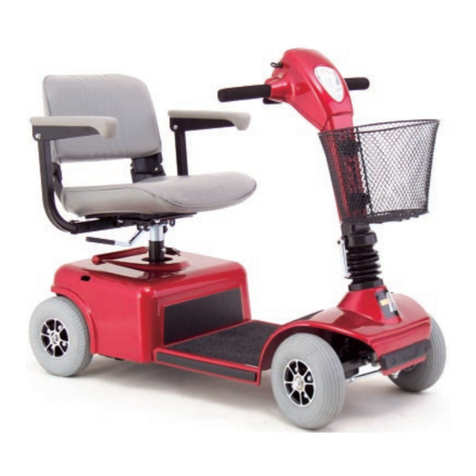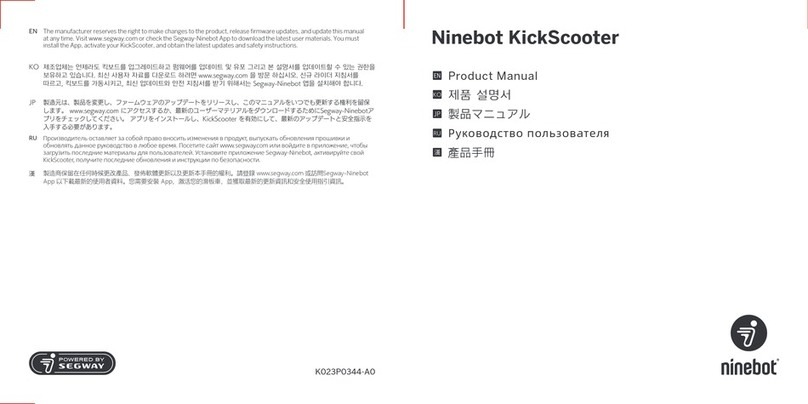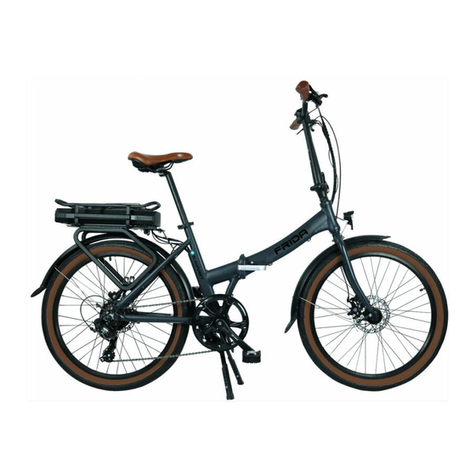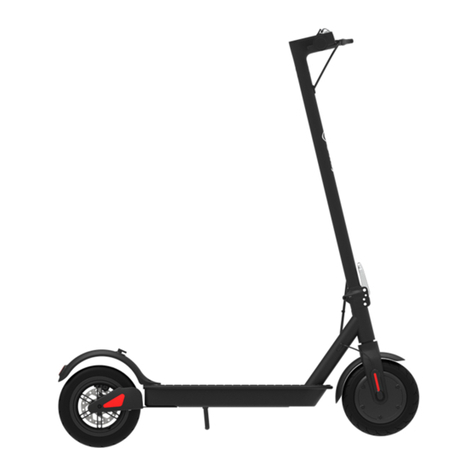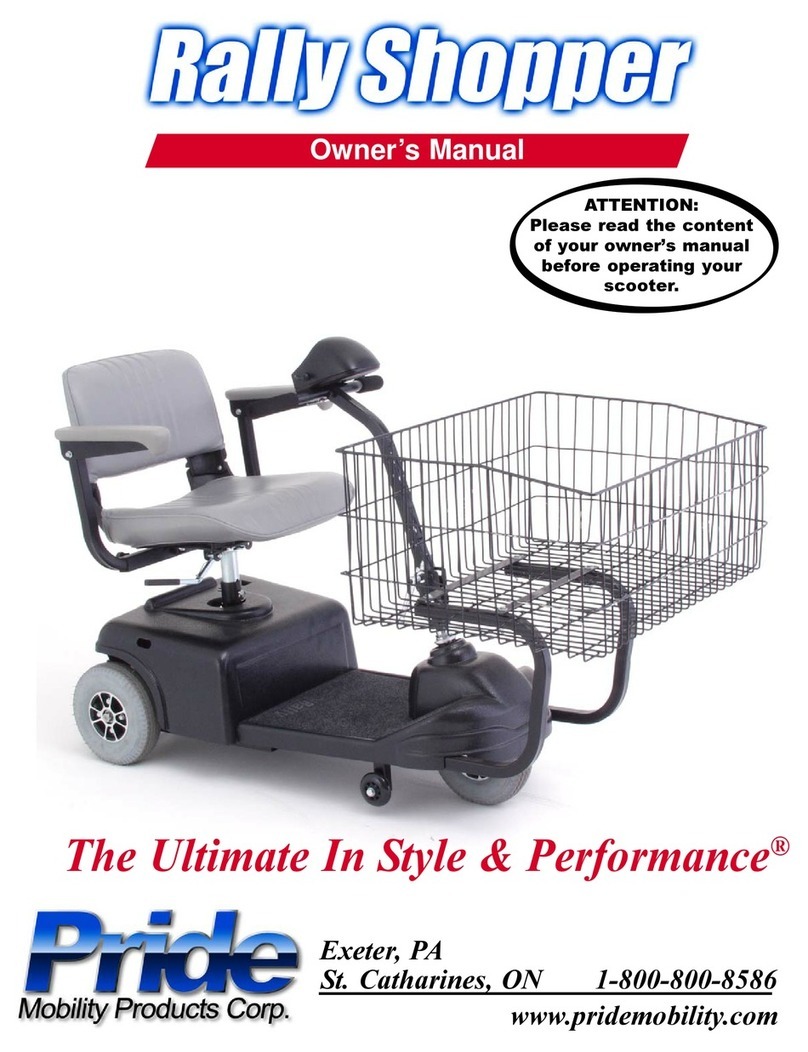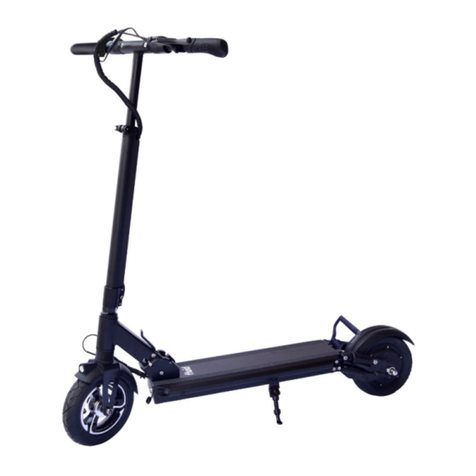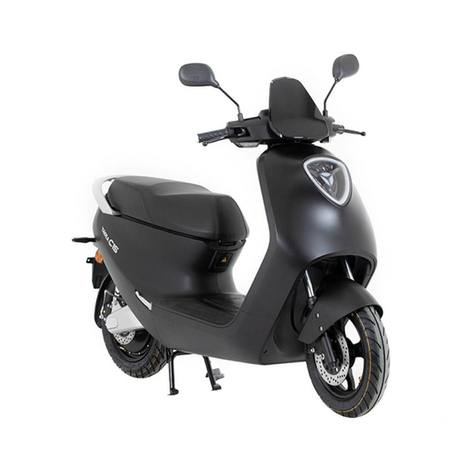go!mate staep TR Series User manual

| 1
Operating Manual
stæp Scooter TR and ER

2 |
Safety Test........................................................................................................................................................................................... 4
Marking of important information...................................................................................................................................................... 5
Important information ........................................................................................................................................................................ 5
Construction ....................................................................................................................................................................................... 6
Unboxing ............................................................................................................................................................................................. 7
Safety and security ............................................................................................................................................................................. 7
Operating conditions........................................................................................................................................................................... 8
Folding Instruction Joint #3 ............................................................................................................................................................... 9
Folding Instruction Joint #2 ............................................................................................................................................................... 10
Folding Instruction Joint #1 ............................................................................................................................................................... 11
Handlebar and Front Wheel Alignment.............................................................................................................................................. 13
Wheels ................................................................................................................................................................................................ 14
Brakes................................................................................................................................................................................................. 14
Stand ................................................................................................................................................................................................... 16
Light .................................................................................................................................................................................................... 17
Carrying the scooter........................................................................................................................................................................... 17
Technics .............................................................................................................................................................................................. 17
TR scooter technical data................................................................................................................................................................... 18
Application TR..................................................................................................................................................................................... 18
ER E-scooter technical data............................................................................................................................................................... 19
Application ER..................................................................................................................................................................................... 19
Multifunction LED ............................................................................................................................................................................... 20
Battery................................................................................................................................................................................................. 21
Disposal .............................................................................................................................................................................................. 23
Care and Maintenance........................................................................................................................................................................ 24
Options in the configuration ............................................................................................................................................................... 26
Optional Accessories .......................................................................................................................................................................... 26
Spare parts ......................................................................................................................................................................................... 26
Warranty.............................................................................................................................................................................................. 27
Table of contents

| 3
Operating manual stæp scooter models
Congratulations on choosing a scooter
from the go!mate range of products
PLEASE READ ALL THE SAFETY AND OPERATING INSTRUCTIONS CAREFULLY BEFORE YOU BEGIN.
stæp TR kick scooter stæp ER E-scooter stæp ER Plus E-scooter
This manual contains basic operating instructions for the stæp scooter.
Vehicle users must use good judgment and common sense to avoid hazards that may occur during operation of the
stæp scooter. Please follow all applicable laws for vehicles and pedestrians.
go!mate GmbH
Auenland 8
25336 Klein Nordende
GERMANY
www.gomate.de
+49 4121 4647700

4 |
The manual will help you understand the use and maintenance of your scooter. We start with the TR series, the
pure kick scooter with currently two models, TR1 and TR3. The number behind the TR indicates the number of
joints and thus the degree of foldability. We will individually describe each joint of the SFS (Smart Folding System)
with its special features.
All points listed here are the basis for the ER series, the electric scooters with five models ER1, ER1 PLUS, ER2,
ER2 PLUS and ER3. In addition to the three different joints, the electric scooters are available...
ER1 and ER2
with a spoked motor
ER1 PLUS and ER2 PLUS
with a rim motor
The E-scooter ER3 can be supplied with a lefty motor developed by go!mate in 2019.
At go!mate, development work on all our models never ceases, so please allow for the fact that changes in design,
equipment and technical specifications may be made at any time. Thus, no claims can be derived from the informa-
tion, images and descriptions in this operating manual.
Safety Test
The scooter has been tested according to DIN EN 14619:2015-06.

| 5
Marking of important information
These symbols mark particularly important information on risks and safety in operation:
This warning draws your attention to possible dangers to your health, your life or that of other persons
that may arise when using the scooter.
This notice draws your attention to possible damage that may occur to the scooter during handling or
operation.
Important information
Currently the ER scooters are not street legal within Germany. At present, only private and company
premises, parks, golf courses, campsites or port areas are considered as areas of application, as far
as no other regulation prohibits the use. Up to now, approval for use on public roads in Germany has
been regulated by the laws of the EU. Occasionally exceptions were made, so that the electric scooter
After the first few kilometers of using the scooter, be sure to check that the following screws are
still tightened: brake calipers, screws at the top and bottom of the head tube (upper screw visible
when joint #1 is open), triple clamp screws, screws for fixing the plank, axle screws for the wheels.
The screws are factory fitted with a screw lock. Nevertheless a check is important. Do not make any
may be used in some countries of the European Union by special permission in road traffic, please inquire about
the respective country guidelines regarding the permission. It is possible to apply for an individual approval at
the Road Traffic Licensing Department.
modifications of your own.

6 |
Construction
Several important design goals are successfully
implemented to maximize the product experience
of „driving a scooter“. This includes low weight,
best driving comfort even in rough terrain, optimal
power transmission and smallest transport dimen-
sions. The scooter is manufactured in Germany,
all tubes and mechanical parts are made of high-
strength aluminum. It is designed without a frame.
The front part of the scooter is connected to the
rear part by a multi-layer plank made of Canadian
maple. The plank is flexible and by interacting with
the pneumatic tires it is forming an ideal, very com-
fortable spring system which protects joints and
spine while driving.
The wheels are suspended on one side (lefty),
except the rear wheel of the electric scooter. If you
have to change the inner tube, the wheels do not
have to be removed.

| 7
Unboxing
We certainly understand that you are excited about trying out your scooter right away. Please preserve yourself in
patience.
Read the whole manual carefully. This ensures that you will be able to always handle the scooter
safely.
Unpack the scooter. It will be delivered folded. Before using the scooter for the first time, a few steps
are necessary to get it on the road.
The scooter has several joints, which have to be unfolded before use and will fold down in a few simp-
le steps for transportation. Make sure that no limbs or hair protrudes into the joint surface. There is a
risk of getting stuck and injured.
Remove all packaging material from the scooter. Make sure that there are no parts of the packaging material in the
brake calipers or brake levers. This could affect the functioning of the powerful braking system.
Safety and security
Practice in secluded areas and do not drive on public roads unless expressly permitted.
For driving in traffic and in the dark, the scooter must be equipped with safety elements (lights, reflectors, etc.) ac-
cording to the road regulations in force in your country. Comply with road traffic regulations as well as the princip-
les of safe operation and use personal protection equipment such as helmet, gloves, sturdy shoes, etc.
Before each ride, ascertain proper functioning of brakes and check the technical condition. Never exceed the maxi-
mum inflation pressure given on the side of the tyre.
Do not exceed the maximum load capacity of 120kg. The scooter is dedicated to only one person. It is not designed
for loads such as acrobatics and jumps. Avoid dangerous actions, keep both hands on the steering wheel.

8 |
All components that regulate the speed (brake pads, rims, tyres, etc.) heat up during use, do not touch them until
they have cooled down!
Operating Conditions
The TR Roller can be used without restrictions in any weather condition. For use in the rain an optional mudguard
system is available which can be used if required. The plank is sealed and therefore will not be damaged in the rain.
The ER scooters are limited to the operating conditions of the LiPo battery. The battery can be used at 0°C to 40°C.
In cold temperatures, the battery must be stored inside a building and warmed up before use. The ER scooters can
also be used in the rain and can also be equipped with mudguards.
If the scooter is parked, the plank should not get in touch with water.
We recommend the following sequence for unfolding the scooter: (1) Joint #3 - (2) Joint #2 - (3) Joint #1.
The sequence 1) Joint #2 - (2) Joint #1 - (3) Joint #3 has been proven to be the best way for folding.
See our drawing on page 6. The folding procedure for each joint is described below:

| 9
Folding Instruction Joint #3
Unfolding Joint #3
The rear joint is connected to the
rear fork by means of a rubber
strap attached to handlebar.
Remove the strap from the brake
lever on the handlebar. Fold the
rear fork towards the plank.
When the fork touches the plank,
the locking device engages on
the rear plate. Make sure that
the locking device is securely
locked by pressing the lever
against the fork tube.
Folding Joint #3
It is recommended that joint #3 of the stæp scooter TR3 (three joints) is the most
recently folded one. The plank should lie on your back. Press the locking pin away from
the rear fork with one hand and then use the other hand to move the fork tube with the
rear wheel to the plank. As soon as the fork is pushed to the limit pull the rubber strap
over the brake lever on the folded handlebar.
Locking
lever

10 |
Folding Instruction Joint #2
Folding Joint #2
Joint #2 is unfolded by pressing the main tube in the
direction of the upper side of the plank. At the end of
the folding process, the locking lever has to be pushed
to the main tube to simplify the gliding into the recess
of the mounting plate.
Locking lever
Auffalten Gelenk 2
It is recommended to fold joint #2 with unfolded handle bar. This makes the folding
process very simple and comfortable. Use one hand to hold the main tube and (1)
pull the safety wedge upwards out of the recess in the mounting plate. Now (2)
press the locking lever to the main tube and turn it to the direction of the undersi-
de of the plank. Push the front wheel past the plank, rotate the scooter (the plank)
180° to the upper side and put it on the ground.
1
2
The locking lever is constructed in two parts and con-
sists of the hook that holds the main tube and a clamping
wedge that secures the hook to the rear. Pull the main
tube to the mounting plate. As soon as the main tube lies

| 11
flatly on the points of support, press the safety wedge of the locking lever firmly into the opening and thus lock the
locking lever. The lever has to be in the front position of the recess and may not be moved with the safety wedge
pushed downwards.
Do not drive without having pushed the safety wedge all the way down and firmly locked the locking
lever. The joint can open in an unsecured state when braking abruptly.
When unfolding joint #2, make sure that the hydraulic hose and the cables of the electric scooter
slide into the main tube. There is a danger of crushing hose and cable, which can impair the scooter’s
function.
Folding Instruction Joint #1
Joint #1 carries the greatest risk of becoming jammed. When
folding, make sure that there are no limbs or hairs in the area
of the two contact surfaces.
Make sure that loose cables and hydraulic hoses do not get
stuck in the lever and interfere with the folding process.

12 |
Unfolding Joint #1
If there is more than one joint, we recommend folding joint #2 first, then joint
#1 and then joint #3 if available. Push the fixing sleeve upwards and release the
locking lever. Pull the lever forward and open it. Pull the handlebar back and fold
completely.
Folding Joint #1
Pull the handlebar up diagonally. As soon as the two joint surfaces lie on top of
each other (the handlebar is straight up), pull the lever with some resistance
against the handlebar tube. When the lever fits closely to the tube, slide the fixing
sleeve over the lever from top to bottom.
Never drive without having locked the handlebar in joint #1 with
lever and fixing sleeve. Otherwise the handlebars will be comple-
tely unstable and driving could be life-threatening.
With a little practice you will be able to easily master the folding process. Folding
usually takes no longer than 10 seconds in any direction which is supported by the
One Touch joints.

| 13
Handlebar and Front Wheel Alignment
Above joint #1 the height of the handlebars can be adjusted by using a clamp on
the head tube. Open the lever of the clamp to adjust the height of the handle-
bars.
Never drive with the clamp open. An unsecured handlebar presents
unnecessary risks to your personal safety.
The clamping force can be adjusted using the silver Allen screw. The clamping
has to reach the necessary strength so that the driver can fully rest his upper
body on the handlebars without the handlebars moving in height. If the handle-
bar moves, turn in the Allen screw. If the clamping lever cannot be fully closed,
unscrew the Allen screw slightly. The handlebars must be aligned exactly at
right angles to the front wheel.
The alignment from the handlebar to the front wheel is particularly impor-
tant, as it has a significant influence on the steering behaviour of the scoo-
ter. If you need to adjust the alignment, slightly open the two Allen screws
on the fork bridge of the standpipe. Adjust the front wheel accurately to the
centre of the plank and then align the handlebar to the correct position at a
right angle to the front wheel. The screws must be tightened with at least 12
NM.
Make sure that the screws of the fork bridge are always tighte-
ned. Driving with loose screws is life-threatening.

14 |
Wheels
All wheels are equipped with high-quality ball bearings. They run very easily. The scooters can be equipped with
street tires (Schwalbe Big Apple) or knobby tires for maximum operational excellence in terrain (Schwalbe Black
Jack). On a smooth surface, the optimum tire pressure is 3 bar at the front and rear. The maximum permissible
pressure must not exceed 4 bar. Lugged tires can be used on off-road terrain with a tire pressure of 1.5 bar, espe-
cially on gravel-like surfaces. A lower pressure cannot be recommended.
Please note, during the journey and through the sun, the tire pressure increases because the tires heat
up. Check the tire pressure regularly.
The hose of the rear wheel has a cranked valve which points outwards. This should make it easier to attach the air
pump‘s valve socket. For the ER models, we recommend an air pump with flexible hose connection, as offered as a
go!mate accessory.
Brakes
The front and rear brake system consists of the brake lever on the handlebar, the brake hose and the brake caliper.
On delivery, the brakes are preset.
The TR models can be equipped with either one brake or two brakes.
The ER models always have two brakes. As standard we use one 140mm brake disc each at the front and rear. At
the front it can be replaced by a 160mm disc. We recommend the use of the larger disc for a weight of the rider >
100kg and if the scooter is used in a very mountainous terrain.
The brake system with two brakes has an enormous braking power, which must be used with caution and overview.
Generally the rear brake is on the right handlebar and the front brake on the left.

| 15
The abrupt actuation of the front brake with maximum braking power can lead to a rollover.
This brake, especially equipped with 160mm disc, should be used in a careful, considered and
well-dosed way.
Practice braking with the scooter to familiarise yourself with the braking behaviour.
Especially the use of the front brake should be practiced.
We recommend that you always start the braking process with the rear brake (right) and then apply the front brake.
When braking you should also shift the weight to the rear.
By the way, it is completely normal for the scooter to flex upwards when braking. This is a consequence of the
dynamics of the flexible planks and desired. The flex becomes larger with increasing braking force at first and then
springs back again. Make sure that the brake pads remain clean and dry. They must not become oily, otherwise they
will lose their efficiency.
Do not drive with dirty, oily or completely worn brake pads. In a dangerous situation this can pre-
vent the scooter to come to a complete stop and endanger yourself and other road users.
In case the brake rubs, you must realign the affected brake caliper. To do so, slightly open the two screws securing
the brake caliper to the frame using a 5mm Allen wrench. First align the front and top caliper to the disc so that
a small gap is visible between the pad and the disc on the left and right. Carefully tighten the screw slightly. Make
sure that the brake caliper does not move. Now you can align the caliper at the rear. When the wheel moves without
grinding noises tighten the rear screw. Tighten both screws properly.

16 |
Stand
An optional stand for the scooter is available. It is attached from the inside to the rear fork. The stand provides a
firm position for the scooter. The scooter must be on secure and flat terrain, otherwise the vehicle could tip over
through it being tail-heavy. Baskets and bags on the handlebars impair the stability.
The stand can be installed retrospectively at the rear lefty fork: Remove the rear brake caliper by unscrewing both
screws. Lift the caliper off the brake disc. Unscrew the screw that holds the rear wheel on the axle and pull the rear
wheel off the axle. Now you have access to the two screw points of the fork. Screw on the stand so that the cranked
part of the mounting plate faces outwards, tighten the screws with 10NM. Slide the rear wheel onto the rear axle
and tighten the axial fixing screw with the washer. Check that the wheel runs smoothly. Mount the brake caliper and
align it.
On scooters with V-fork (ER models) the brake caliper can remain mounted. The drive motor must be removed.
To do this, disconnect the plug connection at the rear of the fender plate. Loosen the motor screws on the left and
right. Then pull the discs with the anti-rotation device outwards until the motor shaft can easily fall downwards
from the dropouts. Now the stand can be mounted. The motor is then reassembled in reverse order.
Always make sure to fold
the stand in before start
riding.

| 17
Light
When driving on public roads, the scooter must be
equipped with safety elements (lights, reflectors,
etc.) according to the road regulations in force in your
country. A battery light set is available as an option for
the scooter. It has very practical dimensions and is also
characterized by an optimum light output for the scoo-
ter. The front light is mounted on the handlebar. The
rear light is mounted on a special light holder which sits on the rear screw of the rear brake caliper. See also the
separate instructions here. Don’t drive in the dark.
Carrying the scooter
TR1 and ER1 are not intended for prolonged carrying. You only fold the handlebars. This
makes transport in the trunk very easy. However, if you need to carry the scooter for longer
distances, we recommend the TR3 and ER3 models.
The scooter is grasped for carrying at the main tube. Carrying the scooter on the long arm is
very comfortable and space-saving. Even taking the scooter on public transport is not a prob-
lem, it is stowed like a piece of luggage.
Technics
Driving the stæp scooter is a great experience. The use of the planks give a kind of surf-feeling. The handling in
curves is dynamic and the scooter‘s feedback from the ground, cornering and propulsion to the rider is direct and
conveys safety.

18 |
stæp TR scooter technical data
Scooter foldable spoke wheels
Folding size TR1 120cmx60cmx-
25cm
Front wheel 16 "
Folding size TR3 70cmx60cmx30cm Rear wheel 12 "
Length 130cm Front wheel geometry Lefty
Height 100cm Rear wheel geometry Lefty
Footboard Height 11cm Frame material aluminum
Footboard Width 15cm Footboard multilayered glued wood
Handlebar height adjustment 14cm Brakes TEKTRO hydraulic 140mm discs
Width handlebar 52cm Loadable up to 120kg, suitable from 7 years
Weight from 7kg CE certification
More muscle groups are required riding a pedal scooter than riding a bicycle, although the kick-off movement looks
simple. The low access and short distance from the road surface optimally transfer the muscle power. To roll and
glide in a force-saving manner, the swing leg must be changed more frequently. The leg should change every six to
ten times. You will be amazed how effectively the scooter accelerates during these changes.
The upper part of the body helps to push the scooter backwards, therefore a higher handlebar is not conducive
(except when strolling through the city).
You will find further information in our FAQ section on our site gomate.de
stæp TR scooter application
Always keep both hands on the handlebar while driving.
Do not drive under the influence of alcohol and observe traffic regulations.

| 19
stæp ER scooter technical data
Scooter with electric drive foldable Weight 13.2kg
Folding size ER1 120cmx60cmx-
25cm
Front wheel geometry Lefty
Folding size ER2 90cmx55cmx-
25cm
Rear wheel geometry V-Fork
Length 130cm Frame material aluminum
Height 100cm Footboard multilayered glued wood
Footboard Height 11cm Brakes TEKTRO hydraulic 140mm discs
Footboard Width 15cm Battery 36V 7.0Ah / 7.5Ah, lockable
Handlebar height adjustment 14cm Loadable up to 120kg, suitable from 14 years
Width handlebar 52cm Thumb throttle lever
Front wheel 16 " Spoke wheel Range about 35km
Rear wheel 12 " Spoke Wheel ER1
and ER2
LCD display meter with 5 speed levels , km or mi
counter
Rear wheel 12 " Rim Wheel ER1
PLUS and ER2 PLUS
36V 250W BAFANG Hub Motor spoked ER1 and
ER2
Speed 20km/h ER1 and ER2 36V 250W Rim Motor ER1 PLUS and ER2 PLUS
Speed 25km/h ER1 PLUS and ER2
PLUS
CE certification
ER application
ER scooters have a 250W motor in the rear wheel, a controller, a Lipo battery, a display and a throttle.

20 |
After you have assembled the scooter, insert the battery into the battery holder. Lock up the battery immediately
after insertion (see chapter Charge Battery). The interlock mechanism of the battery prevents it from falling out of
the holder. Switch on the battery at the bottle‘s On/Off main switch.
An unlocked battery may fall out while driving. The battery may be damaged caused by the impact.
Whenever your travel is interrupted set the main switch on the battery to Off.
The electric scooter is equipped with a BAFANG display on the hub motor (with spokes in the rear wheel). For a rim
motor (motor is fixed to the rim) an LCD-3 display is supplied. The function is described in the separate operating
manual. Please read these carefully before using the unit.
Press the On/Off switch for 5 seconds and turn on the display. Check the state of charge of the battery and switch
on the desired speed level. The throttle lever is active with a selected speed level. If it is pressed, the engine starts.
Multifunction LED
Warning: Only operate the drive lever if you really want to drive off. The engine develops a very high
torque. Operating the lever while stationary can knock the scooter out of your hands and injure
other persons.
The system can be turned off using the on/off switch. Press it for 5 seconds and the system will shut down.
Before you drive off, make sure that you have selected the correct speed level. We recommend that beginners and
older drivers select maximum speed level 4 for the rim motor. This results in a maximum speed of 20km/h which
usually is sufficient. Always bear in mind that a normal cyclist hardly reaches 20km/h in continuous operation.
This manual suits for next models
9
Table of contents
Popular Scooter manuals by other brands
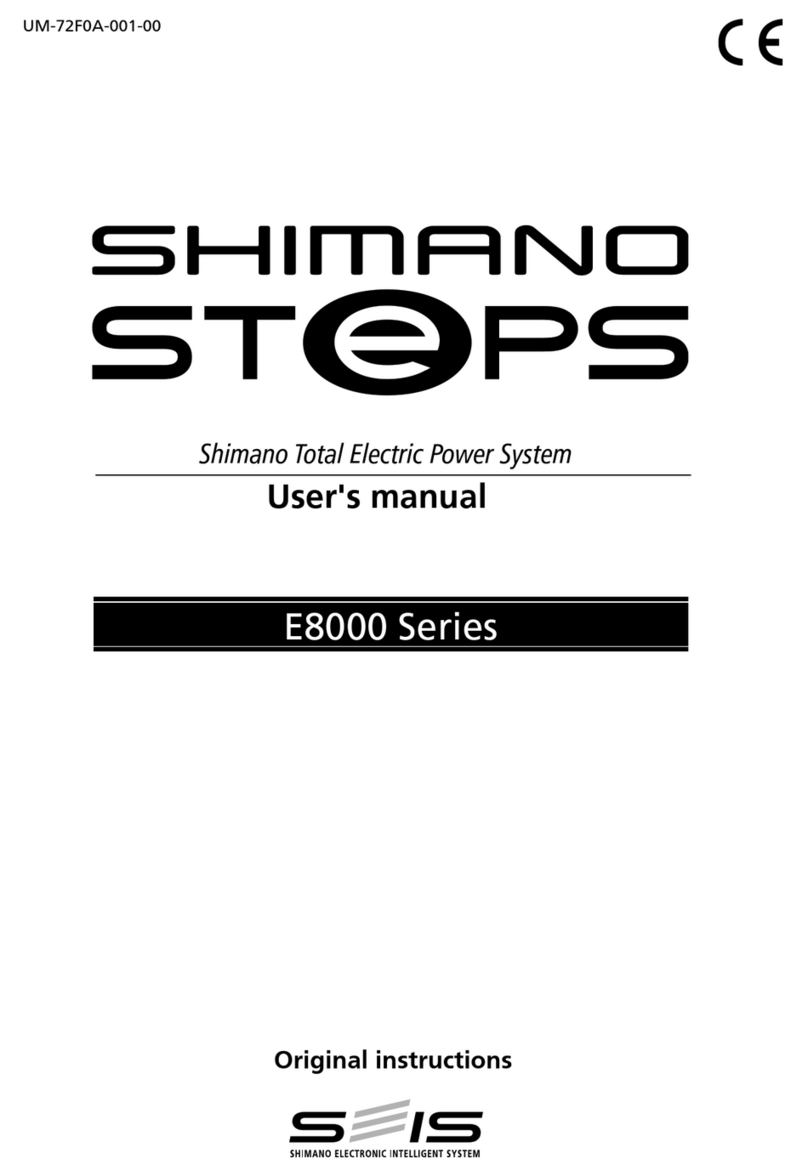
Shimano Steps
Shimano Steps E010 user manual

Heartway Medical Products
Heartway Medical Products S16 user manual

FREEV
FREEV EVS 300 user manual

Clearwell Mobility
Clearwell Mobility Aguna Comfort user manual
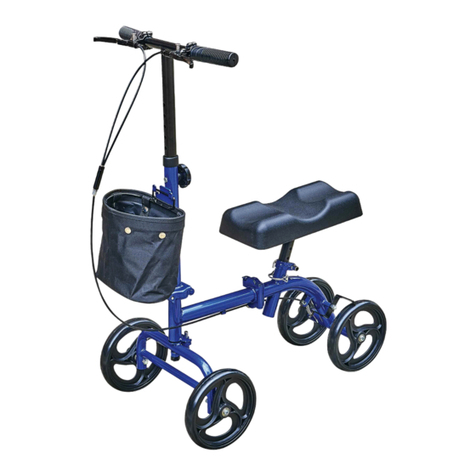
Complete
Complete BlueJay Keep Me Moving Assembly & user manual

Yamaha
Yamaha MAJESTY YP125E owner's manual

